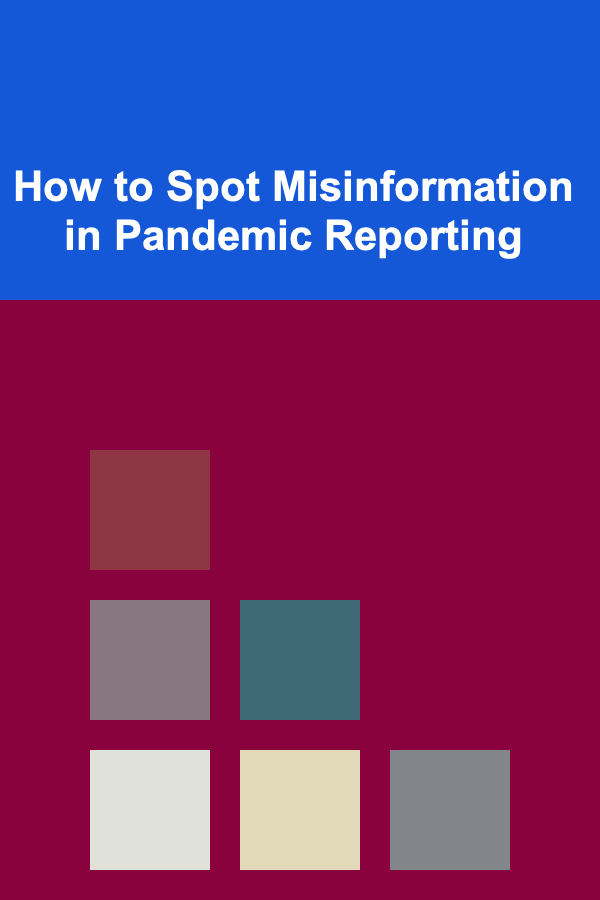
How to Spot Misinformation in Pandemic Reporting
ebook include PDF & Audio bundle (Micro Guide)
$12.99$7.99
Limited Time Offer! Order within the next:

In the age of rapid information sharing, particularly during global crises like pandemics, the ability to spot misinformation has become a crucial skill. Misinformation can spread like wildfire, often faster than the virus itself, complicating public health efforts and leading to widespread confusion and harm. The COVID-19 pandemic, for instance, has highlighted how easily false or misleading information can infiltrate news cycles, social media platforms, and even scientific discourse. This article aims to equip readers with the tools and strategies necessary to spot misinformation in pandemic reporting, providing clarity on how to discern credible information from the noise.
Understanding Misinformation
Before diving into the specifics of how to spot misinformation, it's important to first understand what it is and how it spreads. Misinformation refers to false or inaccurate information that is spread without malicious intent, often by individuals who believe the information is true. In contrast, disinformation is deliberately false information spread with the intention to deceive or manipulate.
During a pandemic, misinformation can take many forms, including:
- False claims about the virus (e.g., how it spreads, symptoms, or treatment)
- Misleading statistics (e.g., inflated numbers, misinterpreted data)
- Unproven cures or treatments (e.g., miracle drugs or alternative medicine)
- Conspiracy theories (e.g., the virus was engineered as a bioweapon)
- Exaggerated impacts (e.g., claims that the virus is far more deadly or less contagious than it really is)
Misinformation can originate from various sources: news outlets, social media, government entities, and even well-meaning individuals. The challenge lies in how easily misinformation can be mistaken for legitimate information, particularly when it's packaged in a way that appeals to emotions, fears, or biases.
Identifying Red Flags in Pandemic Reporting
When evaluating pandemic-related reports, it's essential to look for certain red flags that can help you identify potentially misleading or false information. These warning signs can range from sensational headlines to the source of the information itself.
2.1 Sensational or Exaggerated Headlines
Headlines are often designed to grab attention, but they can also be misleading or exaggerated. For instance, a headline such as "Deadly Virus Mutation Could Endanger Millions" may play on fear and anxiety, even if the article itself doesn't provide sufficient evidence for such a claim.
- What to Look For: Headlines that sound too extreme, lack nuance, or don't reflect the actual content of the article.
- What to Do: Always read beyond the headline. Ensure that the claims in the article are substantiated by credible sources.
2.2 Lack of Credible Sources
A major red flag is when a pandemic report lacks credible sources or references unreliable ones. A trustworthy article should cite experts, research studies, official health organizations, or government bodies. If the piece cites anonymous sources, unnamed experts, or social media posts, it's a warning sign.
- What to Look For: Unverifiable sources, such as anonymous experts or vague references to "research" without a specific citation.
- What to Do: Cross-check the information with reputable sources like the World Health Organization (WHO), the Centers for Disease Control and Prevention (CDC), or peer-reviewed academic journals.
2.3 Appeal to Emotion Over Logic
Misinformation often capitalizes on emotions like fear, anger, or confusion. Articles that make you feel panic or moral outrage without presenting logical, evidence-based arguments should raise suspicion. Emotional appeals are often used to distract from the lack of scientific rigor or factual evidence.
- What to Look For: Strong emotional language like "panic," "disaster," or "catastrophic," which aims to provoke a reaction rather than inform.
- What to Do: Stay calm and assess the article with a critical eye. Does the information present facts and evidence, or does it just manipulate your emotions?
2.4 Too Good (or Bad) to Be True
Misinformation about pandemics can sometimes promise miraculous solutions or paint a picture of apocalyptic disaster. This could be claims of miraculous cures for the virus or alarmist reports predicting widespread devastation that are not supported by scientific data.
- What to Look For: Claims that sound too extraordinary to be true, like a "cure-all" for the disease or dire predictions of widespread death without scientific backing.
- What to Do: Investigate the claims further. Seek out peer-reviewed studies or statements from authoritative public health bodies.
2.5 Misleading or Cherry-Picked Statistics
Data can be manipulated to support specific narratives. For example, statistics about infection rates, death rates, or vaccine efficacy can be cherry-picked to mislead readers. This can involve showing data out of context or manipulating the way it's presented.
- What to Look For: Graphs or statistics that lack context, don't include a timeline, or present numbers without explaining how they were calculated or sourced.
- What to Do: Look for full datasets and explanations from credible sources. A good report will provide clear methodology and explain how the data was obtained.
2.6 Lack of Peer Review
One of the hallmarks of reliable science is peer review---a process where other experts in the field assess the validity and quality of research before it's published. A report based on non-peer-reviewed studies or preprints (research that has not been vetted by experts) can be a red flag.
- What to Look For: Claims that are based on non-peer-reviewed studies or early-stage research.
- What to Do: Look for studies published in reputable journals or reviewed by multiple experts in the field. Be cautious about reports based on preprints unless they have been verified.
Evaluating Sources of Pandemic Reporting
Knowing where the information comes from is just as important as what the information says. Sources can significantly affect the reliability of a report.
3.1 Mainstream Media Outlets
Mainstream media outlets like BBC, The New York Times, The Guardian, and Reuters often adhere to journalistic standards and fact-checking protocols, making them reliable sources for pandemic reporting. However, even mainstream outlets can sometimes present sensationalized or imbalanced coverage, particularly if the story is complex or controversial.
- What to Look For: Reports from recognized journalists, experts in the field, and reliable news organizations.
- What to Do: While mainstream outlets are generally trustworthy, verify the information with other reliable sources if the claim seems especially contentious or alarming.
3.2 Alternative News Sources
Alternative or independent media can offer different perspectives, but they can also be a breeding ground for misinformation. Some outlets may downplay the severity of the pandemic, promote conspiracy theories, or present non-expert opinions as facts.
- What to Look For: Reports that don't cite reputable experts or that make sweeping claims without evidence.
- What to Do: Cross-check the claims with more reliable, fact-checked sources. Avoid outlets that do not provide verifiable citations or that frequently engage in fear-mongering or sensationalism.
3.3 Social Media and Blogs
Social media platforms and personal blogs can be valuable for sharing experiences and opinions, but they are also rife with misinformation. Anyone can post information on these platforms, and it's easy for rumors or pseudoscience to spread quickly.
- What to Look For: Posts without evidence, dramatic claims, or health advice from non-professionals.
- What to Do: Treat information from social media as a starting point for further investigation. Always check with scientific organizations, health experts, or credible news outlets before believing or sharing the information.
Fact-Checking Resources and Tools
In the fight against misinformation, fact-checking websites and tools play a vital role. They can help you verify the accuracy of claims made in pandemic reporting.
4.1 Fact-Checking Websites
Some of the most trusted fact-checking organizations include:
- Snopes: Known for debunking viral rumors and hoaxes.
- FactCheck.org: Provides evidence-based verification of claims made in politics and science.
- PolitiFact: Focuses on evaluating the truthfulness of political statements, but often includes health-related claims as well.
These websites have dedicated teams that assess news stories and viral claims, making them invaluable tools for spotting misinformation.
4.2 Scientific Journals and Databases
Peer-reviewed scientific literature is one of the most reliable sources of information. When in doubt, consult databases like:
- PubMed: A repository of biomedical literature, often the gold standard for health-related research.
- Google Scholar: A free search engine for scholarly articles, which often includes peer-reviewed papers and official studies.
- ClinicalTrials.gov: A database of registered clinical trials, useful for finding evidence on medical treatments and vaccines.
Best Practices for Navigating Pandemic Reporting
To avoid falling prey to misinformation during a pandemic, it's important to cultivate a healthy skepticism and always verify before you trust. Here are some best practices to help you navigate pandemic reporting:
- Verify Before Sharing: Before sharing any pandemic-related news, especially on social media, double-check the information and confirm its credibility.
- Cross-Reference Sources: Look for multiple reputable sources to corroborate the information before accepting it as true.
- Consider the Source: Pay attention to the outlet and the expert quoted. Are they reputable? Are they known for being reliable and objective?
- Avoid Echo Chambers: Avoid getting all your information from a single source or group that only reinforces your existing beliefs. Instead, diversify your sources and opinions.
- Seek Expert Opinions: Always prioritize information from medical professionals, epidemiologists, and public health authorities.
Conclusion
The ability to spot misinformation is an essential skill, especially during a pandemic. As the world continues to navigate these global health crises, we must remain vigilant in evaluating the information we encounter and share. By looking for red flags, verifying sources, and using fact-checking tools, we can all contribute to stopping the spread of misinformation and ensuring that the truth prevails.
In times of crisis, clear, reliable information is crucial for public health and safety. By taking the time to critically assess the information we consume, we can protect ourselves, our communities, and our society from the harm caused by misinformation.
Reading More From Our Other Websites
- [Home Family Activity 101] How to Host a Family Movie Marathon That Everyone Will Love
- [Home Maintenance 101] How to Care for Your Home's Copper Pipes to Prevent Corrosion
- [Star Gazing Tip 101] Moonlit Nights and Meteor Showers: Romantic Getaways for Star Lovers
- [Home Budget Decorating 101] How to Decorate with Textiles (Throws, Pillows, Rugs) Affordably
- [Home Pet Care 101] How to Maintain Pet Skin Care: Tips for Healthy Skin
- [Home Storage Solution 101] How to Utilize a Sofa with Built-In Storage for Your Living Room
- [Personal Care Tips 101] How to Apply Sunscreen on Your Scalp to Prevent Sunburn
- [Home Rental Property 101] Best Ways to Rent Out Your Home: Tips for Success
- [Organization Tip 101] How to Set Up a Family Command Center in Your Entryway
- [Personal Care Tips 101] How to Use Shaving Cream for a Pain-Free Underarm Shave

How to Clean and Maintain Your Home's Carpets for Longevity
Read More
How to Handle Tenant Complaints Professionally and Effectively
Read More
How to Organize a Family Charity Drive for a Good Cause
Read More
Crafting Exotic Coffee Drinks from Around the World
Read More
How to Get a Secured Credit Card Without a Bank Account
Read More
10 Tips for Understanding Political Ideologies
Read MoreOther Products

How to Clean and Maintain Your Home's Carpets for Longevity
Read More
How to Handle Tenant Complaints Professionally and Effectively
Read More
How to Organize a Family Charity Drive for a Good Cause
Read More
Crafting Exotic Coffee Drinks from Around the World
Read More
How to Get a Secured Credit Card Without a Bank Account
Read More